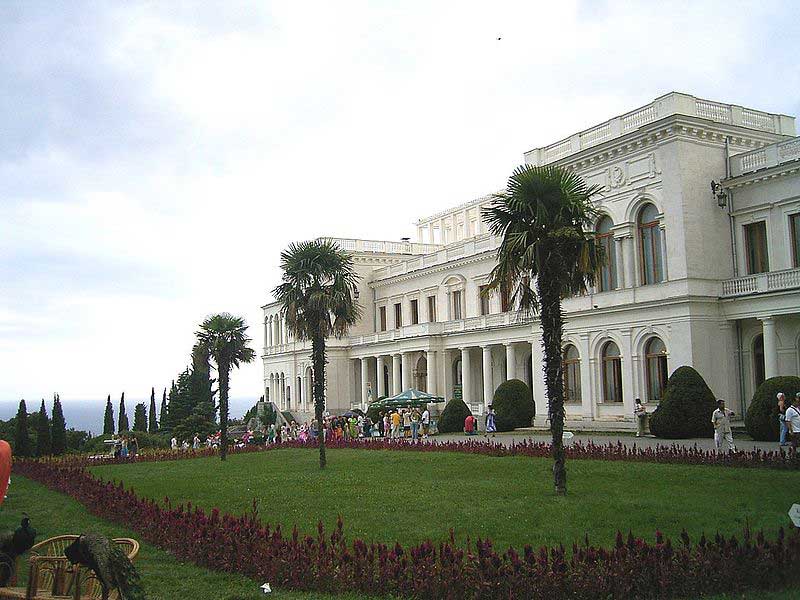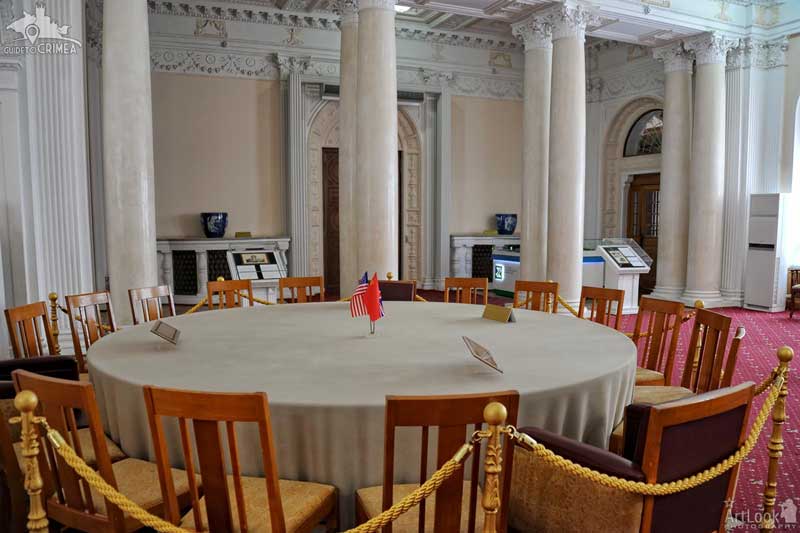
The white-stone Livadia Palace, located at Baturyna St, 44-а, in the small town of Livadiya, in southern Crimea, not far from the city of Yalta, served as a summer residence of the Russian emperors in the 19th and 20th centuries. Built in Italian Neo-Renaissance style with Byzantine, Eastern and Gothic motifs, the palace, considered the most beautiful architectural installation of southern Crimea, is also an important historical monument, where the Yalta Conference was held in 1945.
At the conference, the heads of government of the United States, the United Kingdom and the Soviet Union met to discuss the postwar reorganization of Germany and Europe. The participating states, the Big Three, were represented by President Franklin Roosevelt of the USA, Prime Minister Winston Churchill of the UK and Joseph Stalin, the General Secretary of the Central Committee of the Communist Party of the Soviet Union. During that time, the Livadia Palace temporarily served as the quarters of President Franklin Roosevelt and other members of the American delegation.

Livadia, known for its healing climate, became a popular resort, especially following the development of the railroads in the 19th century. However, it all started in 1834, when Polish magnate Lev Potockiy bought the tiny Livadia village and built his mansion there. In 1860, Emperor Alexander II of Russia bought the mansion and commissioned architect Ippolito Monighetti to turn it into a large Imperial palace, along with a small palace and a chapel. After completion of the project, he gifted the property to his first wife and political adviser, Maria Alexandrovna.
While the palace was frequented by Alexander II, his successor, Alexander III, who built the Minor Palace, used to live and died in the small palace. After his death, his son Nicholas II, the last Russian Tsar, known in the Russian Orthodox Church as Saint Nicholas the Passion-Bearer, decided to demolish the comparatively larger palace, as it started decaying at the onset of the 20th century and replace it with a new and bigger structure, but preserve the smaller palace, where his father died. Nevertheless, smaller palace was subsequently destroyed during World War II.

According to the order by Nicholas II, the original palaces were torn down and around 1909, Nikolay Krasnov, one of the most famous architects of Yalta, designer of the Moorish Revival Styled Dulber Palace in Koreiz, was commissioned to prepare appropriate plans for a new imperial palace on the site.
After lots of discussions with the Imperial Family, it was decided that all the four facades of the proposed palace should look different and finally, Nikolay Krasnov created a real architectural masterpiece, which harmoniously matched the picturesque landscape. The foundation was laid in 1910 and only after 17 months of construction, the new palace was inaugurated on 11 September 1911.


Built of white Crimean limestone in Italian Neo-Renaissance style, the Livadia Palace features an arched portico of Carrara marble, an Italian patio and a spacious Arabic patio. In addition, it has an impressive Florentine tower and ornamented Bramantesque windows, which is a characteristic feature of Romanesque architecture, consisting of a pair of arched windows, separated by a pillar or a slender column and often set within a larger arch. Apart from that it is equipped with a .balcony-belvedere to take advantage of a fine or scenic view and several multiple bays with jasper vases. A gallery connects the palace with a neo-Byzantine church of the Exaltation of the Cross, built in 1866 by Ippolit Antonovich Monighetti, a Russian architect of Swiss descent. However, the most Italian element of the palace is its inner courtyard, surrounded by arcades, full of greenery and decorated with a marble fountain in the middle.

The palace contains 116 rooms, with different styles of interior furnishing, including a Neo-baroque dining room, an English billiard room, a Pompeian vestibule and a Jacob-style study of maple wood, which earned the sincere admiration of Nicholas II. The rooms also include the apartments of the Emperor and Empress, complete with an office, bedroom and reception rooms, the Roosevelt and Churchill Memorial Library Cabinets, the Great White Hall, former Parade Dining room, containing the round table at which the Big Three, Joseph Stalin, Franklin Roosevelt, and Winston Churchill, met at 5 pm on 4 February 1945.

After the Russian Revolution, the Livadia Palace lost its dignity and glamour as the summer retreat of the royal family and briefly became a museum preserving the heritage of imperial family life. Later on, it was turned into a tuberculosis sanatorium for peasants for a certain period, when most of its historical furnishings have been lost. Fortunately, some of the classic décor and the interiors still remain, which include an English-style billiards room, an invaluable mahogany-panelled reception cabinet with brass fitting, the beautiful Carrara marble columns and fireplace in the main dining room and a handmade rug depicting Nicholas II with his family. However, from the end of World War II until Stalin's death in 1953, it served as a dacha, a summer house, for state officials. Finally, only in 1993, the palace was reopened as a museum, exhibiting the bedroom of the Royal personages, the Emperor’s study, the living room of the Empress, the lavishly furnished dining room, the billiard room, the library and the others.